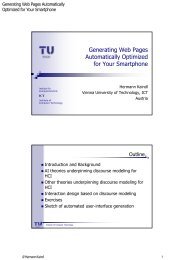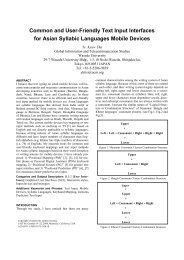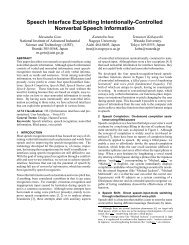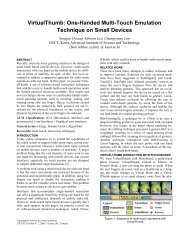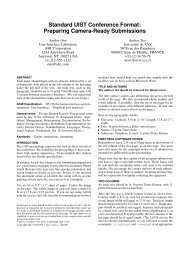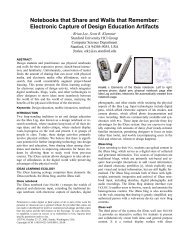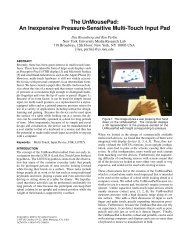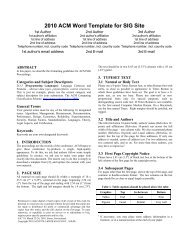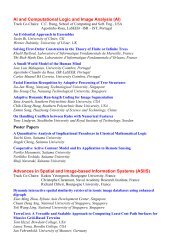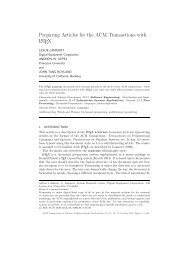API Design Matters Stonebraker and Seltzer - RabbitMQ
API Design Matters Stonebraker and Seltzer - RabbitMQ
API Design Matters Stonebraker and Seltzer - RabbitMQ
You also want an ePaper? Increase the reach of your titles
YUMPU automatically turns print PDFs into web optimized ePapers that Google loves.
example. The exchange concept is how AMQP brings<br />
together <strong>and</strong> abstracts different middleware delivery mod-<br />
els. It is also the main extension point in the protocol.<br />
A client chooses the exchange used to deliver each<br />
message as it is published. The exchange looks at the<br />
information in the headers of a message <strong>and</strong> selects where<br />
they should be transferred to. This is how AMQP brings<br />
the various messaging idioms together—clients can select<br />
which exchange should route their messages.<br />
Several exchanges must be supported by a compliant<br />
AMQP implementation:<br />
• The direct exchange will queue a message directly at<br />
a single queue, choosing the queue on the basis of the<br />
“routing key” header in the message <strong>and</strong> matching it by<br />
name. This is how a letter carrier delivers a message to a<br />
postal address.<br />
• The topic exchange will copy <strong>and</strong> queue the message to<br />
all clients that have expressed an interest based on a rapid<br />
pattern match with the routing key header. You can think<br />
of the routing key as an address, but it is a more abstract<br />
concept useful to several types of routing.<br />
• The headers exchange will examine all the headers in<br />
a message, evaluating them against query predicates pro-<br />
vided by interested clients using those predicates to select<br />
the final queues, copying the message as necessary.<br />
Throughout this process, exchanges never store mes-<br />
sages, but they do retain binding parameters supplied to<br />
them by the clients using them. These bindings are the<br />
arguments to the exchange routing functions that enable<br />
the selection of one or more queues.<br />
BinDingS<br />
The arguments supplied to exchanges to enable the<br />
routing of messages are known as bindings (see figure 2).<br />
Bindings vary depending on the nature of the exchange;<br />
the direct exchange requires less binding information<br />
than the headers exchange. Notably, it is not always clear<br />
AMQP Semantic Model<br />
file transfer<br />
messaging exchanges<br />
transactions ctl<br />
FIG 2<br />
more queue: www.acmqueue.com<br />
bindings<br />
which entity should provide the binding information for<br />
a particular messaging interaction. In the direct exchange,<br />
the sender is providing the association between a routing<br />
key <strong>and</strong> the desired destination queue. This is the origin<br />
of the “destination” addressing idiom so common to JMS<br />
<strong>and</strong> other queuing products.<br />
In the topic exchange, it is the receiving client that<br />
provides the binding information, specifying that when<br />
the topic exchange sees a message that matches any given<br />
client(s’) binding(s), the message should be delivered to<br />
all of them.<br />
AMQP has no concept of a “destination,” since it<br />
does not make sense for consumer-driven messaging. It<br />
would limit its abstract routing capabilities. The concept<br />
of bindings <strong>and</strong> the convention of using a routing key as<br />
the default addressing information overcome the artificial<br />
divisions that have existed in many messaging products.<br />
iMPlEMENTATiONS<br />
A st<strong>and</strong>ard is nothing without implementations. AMQP<br />
has several available now. The first implementation is<br />
iMatix OpenAMQ (http://www.openamq.org), which is<br />
a C implementation of the server in production use at<br />
JPMorgan.<br />
Apache’s Qpid project has entered incubation (http://<br />
incubator.apache.org/projects/qpid.html). It will be<br />
Apache’s multilanguage implementation of AMQP, with<br />
servers available in C++ <strong>and</strong> Java, <strong>and</strong> clients available in<br />
C, C++, Java JMS, Python, <strong>and</strong> Ruby on Rails, with more<br />
to follow. Qpid has a very active development community<br />
<strong>and</strong> is making rapid progress toward its M2 release.<br />
Also, Qpid is being used as the basis for several commercial<br />
offerings, notably from IONA <strong>and</strong> Red Hat.<br />
Most recently, <strong>and</strong> intriguingly, Rabbit Technologies<br />
has developed an implementation on the Erlang/OTP<br />
(Open Telecom Platform), building on that language’s<br />
strong support for parallelism <strong>and</strong> networking.<br />
Of course, you should<br />
be able to mix <strong>and</strong> match<br />
client <strong>and</strong> server compo-<br />
queue<br />
nents from any vendor<br />
product—Qpid’s Java client<br />
talking to <strong>RabbitMQ</strong>’s<br />
queue<br />
Erlang server, for example.<br />
The best way to learn<br />
more about AMQP is to<br />
queue<br />
visit http://www.amqp.org,<br />
where you can download<br />
the specification, try one of<br />
the free implementations,<br />
ACM QUEUE May/June 2007 53



